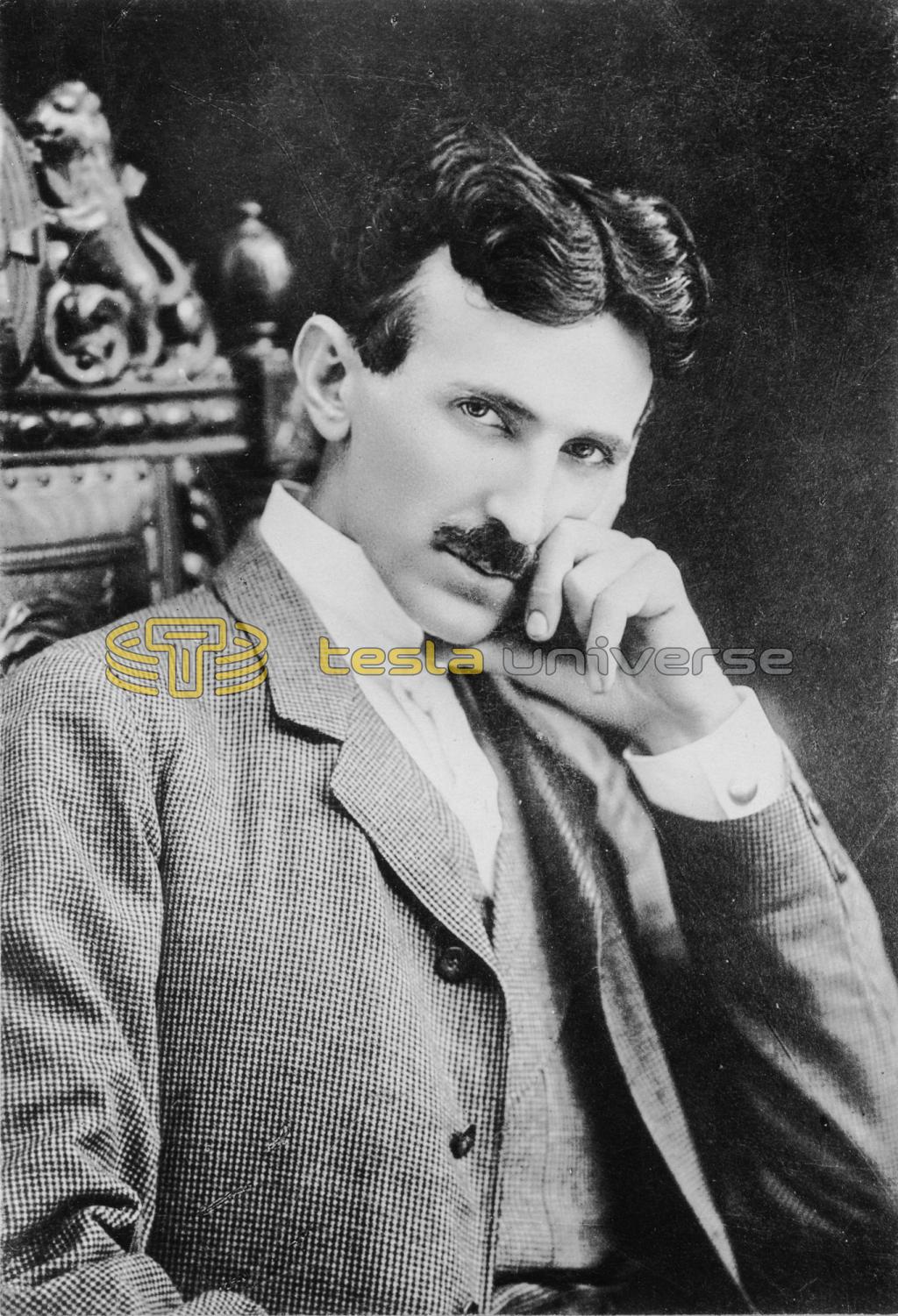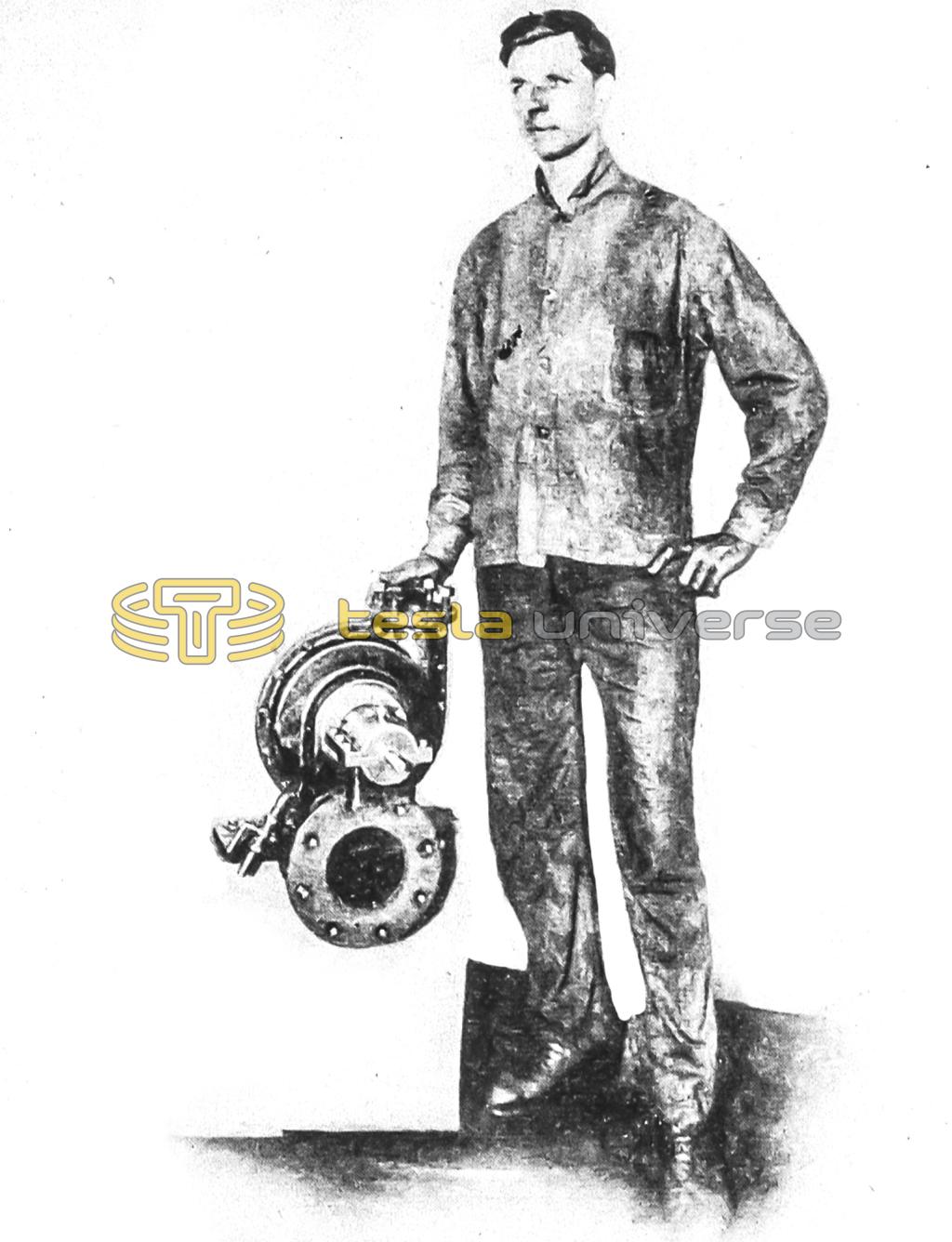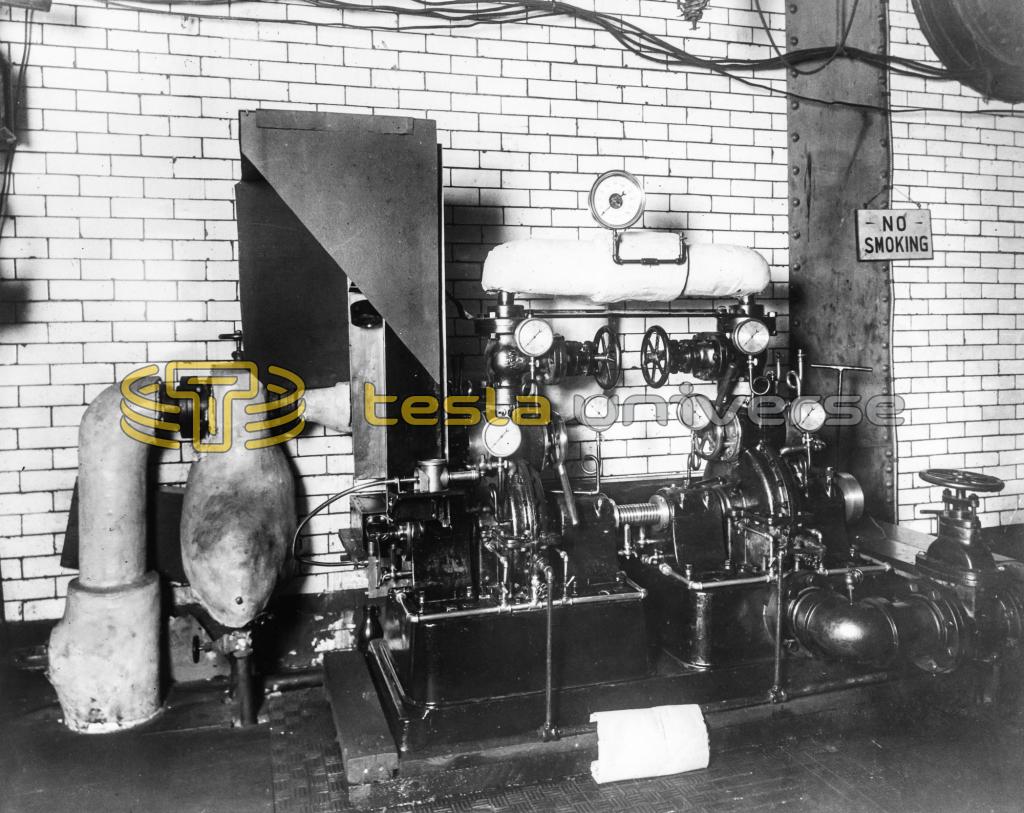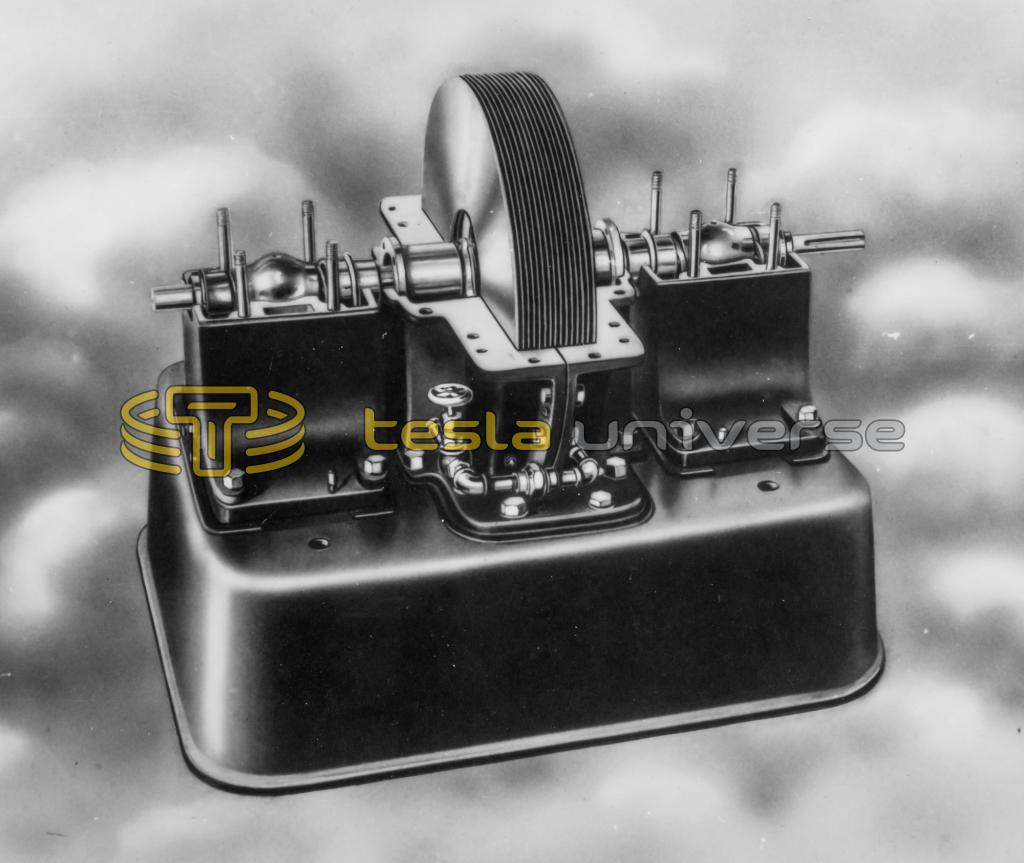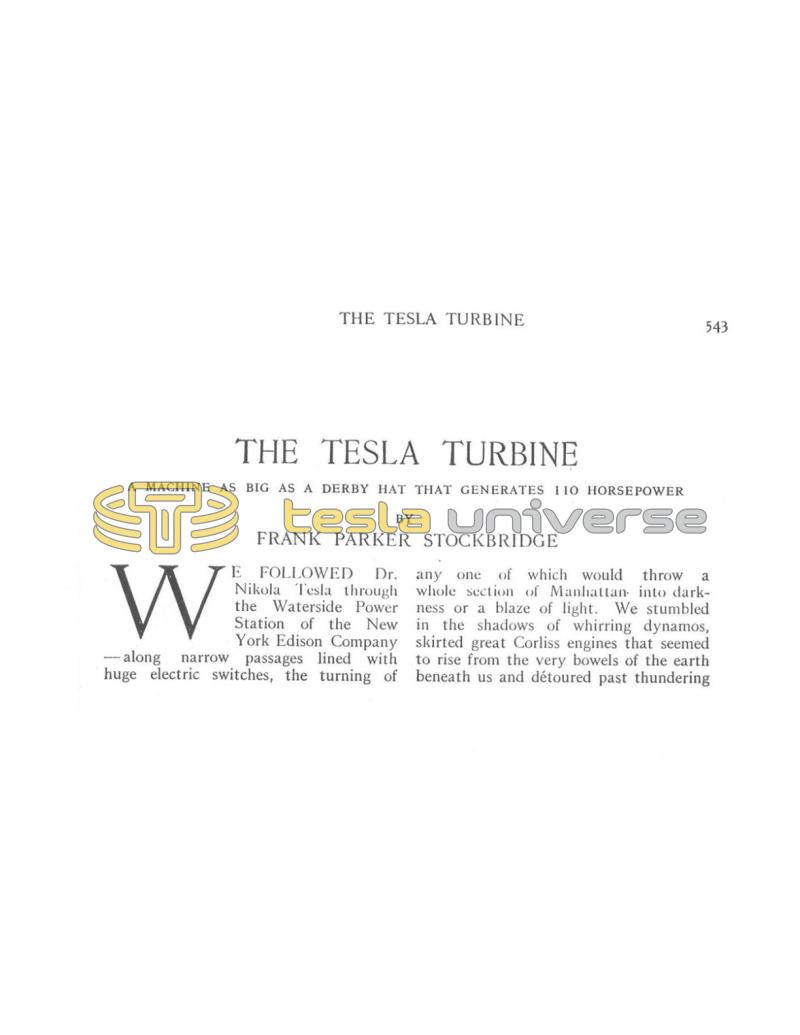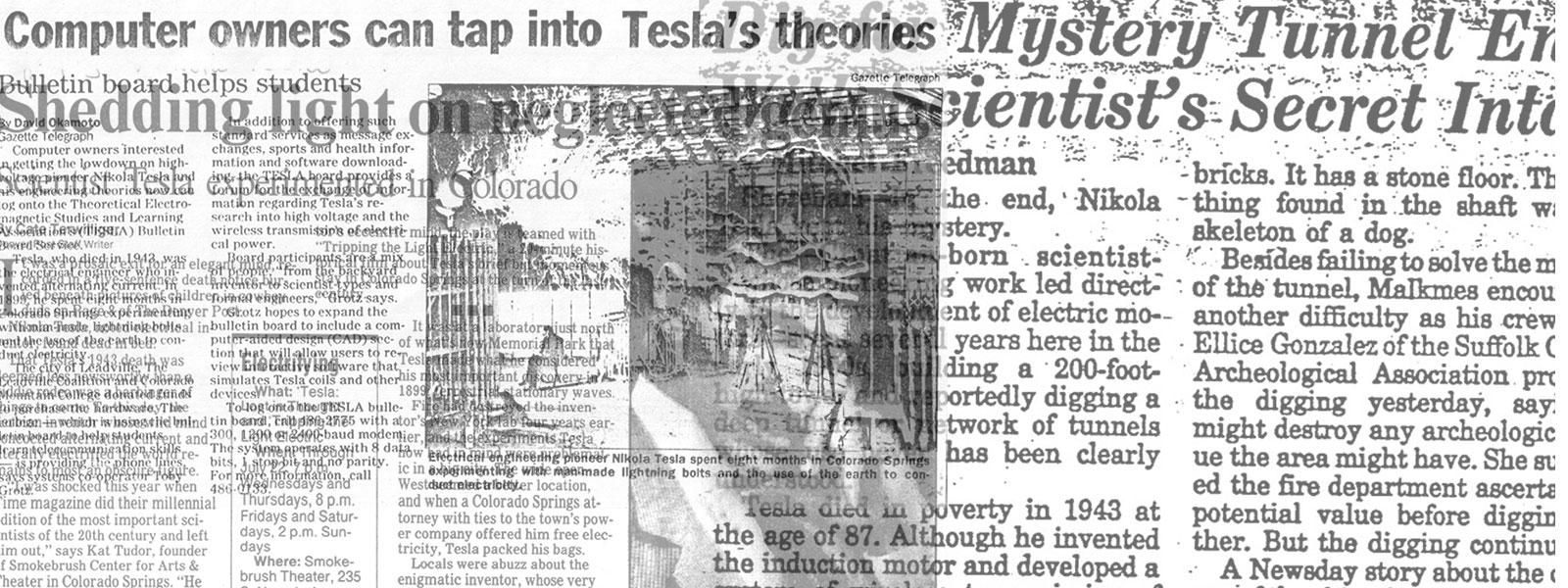
Nikola Tesla Articles
The Tesla Turbine
A Machine as Big as a Derby Hat That Generates 110 Horsepower
We followed Dr. Nikola Tesla through the Waterside Power Station of the New York Edison Company - along narrow passages lined with huge electric switches, the turning of any one of which would throw a whole section of Manhattan into darkness or a blaze of light. We stumbled in the shadows of whirring dynamos, skirted great Corliss engines that seemed to rise from the very bowels of the earth beneath us and détoured past thundering turbines. Before the largest turbine we paused for a moment.
“Here,” said Dr. Tesla, pointing to the huge machine, “is a triumph of engineering skill. This turbo-dynamo, the largest ever made, developing 30,000 horsepower, was built from plans worked out on paper. It was never tested until it was erected here and it worked perfectly from the first turning on of steam. That is engineering. But that is not what we are here for.”
We pressed on until we reached an open space where a mechanic in blue jeans was wiping the oil and grease from a machine so tiny in comparison with the gigantic turbine we had just inspected that it seemed like a toy.
“Here it is,” said the tall, thin man - or rather he shouted, for the noise of a hundred thousand horsepower of moving machinery is not conducive to free vocal expression. “Better take off your coats,” he continued, “for it is a cold night and it gets pretty hot in here.”
We followed his advice and example and stripped down to shirt-sleeves.
“Turn on the steam,” said the inventor to the mechanic. The workman gave a valve a short turn. From inside the little machine, which seemed to be composed of two identical parts connected by a spiral spring, came a humming sound; the connecting spring began to revolve so rapidly that it looked like a solid bar of steel and the floor under our feet shook with rapid vibrations which died down. I glanced at a speed-gauge attached to what seemed to be the main shaft of the device and saw that it was registering 7,000 revolutions a minute. I looked up at the main steam gauge overhead and saw a pressure of ninety pounds to the square inch indicated.
Dr. Nikola Tesla, inventor of the alternating-current motor, and pioneer in research into high-tension electric currents generally, was demonstrating his latest invention - a steam turbine, different in principle from any heretofore in use and one which will take less room and less coal per horsepower than the best engines now running. “It’s up to its normal speed now - about nine thousand revolutions,” said Dr. Tesla, and the tachometer bore out his statement. “You see, for testing purposes, I have these two turbines connected by this torsion spring. The steam is acting in opposite directions in the two machines. In one, the heat energy is converted into mechanical power. In the other, mechanical power is turned back into heat. One is working against the other, and by means of this beam of light we can tell how much the spring is twisted and consequently how much power we are developing. Every degree marked off on this scale indicates twenty-two horsepower.” We looked at the scale. The beam of light stood at the division marked “10.”
“Two hundred and twenty horsepower,” said Dr. Tesla. “We can do better than that.” He opened the steam valves a trifle more, giving more power to the motive end of the combination and more resistance to the “brake” end. The scale indicated 330 horsepower. “These casings are not constructed for much higher steam pressures, or I could show you something more wonderful than that. These engines could readily develop 1,000 horsepower,” he said, as we watched the turbine running smoothly, steadily, almost noiselessly except for that single clear, musical note.
Standing nearby was another and smaller machine of the same type, connected through a gear-box with a dynamo. The engine itself would almost go into an ordinary hat-box. At a signal from Dr. Tesla the mechanic turned on the steam. Instantly, without the fraction of a second’s apparent delay, the dynamo was under full speed, and from the end containing the motor rose the same clear note, indicating a well-balanced machine running freely at its normal speed.
“This little turbine has developed 110 horsepower under tests,” said Dr. Tesla. It was about the size of a derby hat.
“Careful tests have shown that the single-stage turbine, running at 9,000 revolutions per minute, with a steam pressure of 125 pounds at the inlet, developing 200 brake horsepower, consumes 38 pounds of saturated steam per horsepower hour,” said Dr. Tesla.
“But I can do better than that by compounding,” he added. “The heat-drop under the conditions I named is only 130 British thermal units, and that is less than one third of the amount available under modern conditions of superheated steam and high vacuum. By compounding the turbines I shall get a steam consumption of not more than eight pounds per horsepower hour.
“The most efficient steam engines in America, big, slow-moving pumping engines working under ideal conditions and constant load, use about eleven pounds. I have undertaken a contract to produce one which will consume less than nine.
“The idea on which all steam engines - gas engines, too - have been built in the past was that there must be something solid and substantial for the steam to push against. The piston of a reciprocating engine and the blades and buckets of modern turbine engines are examples of what I mean. That idea has made them rather complicated devices, requiring careful fitting for efficient operation, great expense for repairs, and, especially in the case of turbines, great liability to damage. It has also made them bulky and heavy.
“What I have done is to discard entirely the idea that there must be a solid wall in front of the steam and to apply in a practical way, for the first time, two properties which every physicist knows to be common to all fluids (including steam and gas) but which have not been utilized. These are adhesion and viscosity.
“You know that water has a tendency to stick to a solid surface. That is the property of adhesion which every fluid - gas, steam, water, or whatever it be - possesses. You also know that a drop of water tends to retain its form, even against a considerable force, such as gravity. That is viscosity, the tendency to resist molecular separation, and all fluids have this property, too.
“It occurred to me that if I should take circular disks, mount them on a shaft through their centres, space them a little distance apart, and let some fluid under pressure, such as steam or gas, enter the interstices between the disks in a tangential direction, the fluid, as it moved, owing to these properties of adhesion and viscosity, would tend to drag the disks along and transmit its energy to them. It happened just as I had thought it would, and that is the principle of this turbine. It utilizes the very properties which cause all the loss of power in other turbines.
“Inside of the casings of those engines you saw - instead of buckets or blades or vanes on the edge of a wheel, there are simple disks of steel mounted on the shaft. In the two larger turbines these disks are eighteen inches in diameter and one thirty-second of an inch thick. There are twenty-three of them, spaced a little distance apart, the whole making up a total thickness of three and one half inches. The steam, entering at the periphery, follows a spiral path toward the centre, where openings are provided through which it exhausts. As the disks rotate and the speed increases, the path of the steam lengthens until it completes a number of turns before reaching the outlet - and it is working all the time. In the ordinary turbine the steam passes only around the periphery and the central portion of the wheel is useless. Moreover, every engineer knows that, when a fluid is used as a vehicle of energy, the highest possible economy can be obtained only when the changes in the direction and velocity of movement of the fluid are made as gradual and easy as possible. In previous forms of turbines more or less sudden changes of speed and direction are involved.”
Later, in his laboratory in the Metropolitan Tower, discussing the commendations which eminent engineers, many of them with international reputations, have expressed concerning his turbine, Dr. Tesla summarized the points that make it a long step in advance in mechanical engineering.
“To say nothing of it being a new application of mechanical principles,” he said; “it has many decided advantages. First of these is its simplicity. It is comparatively inexpensive to construct, because nothing but the bearings need be accurately fitted, and exact clearances are not essential. Then there is nothing in it to get out of order and the disks can easily be replaced by any competent mechanic. It can be reversed without complex or cumbersome apparatus - all that is needed is a two-way valve to let the steam in at one side or the other, as desired. Reversing an ordinary turbine is next to impossible.
“My machine occupies, as you saw little space - the 110 horsepower turbine has disks only of 9¾ inches in diameter - and in consequence it weighs very little. The lightest engines now in use weigh 2½ pounds to the horsepower, while these, in their crudest forms, weigh less than that, and I expect to be able to produce 10 horsepower to the pound. Using gas instead of steam it gives most gratifying results, doing away with the complicated valves and springs of the prevailing types of gas engines. Another interesting application of it is as a pump, either for water or for air. The same disk arrangement is used, but the casing is so arranged, when built as a pump, that the fluid enters at the centre and is ejected at the periphery.” He led the way into an adjoining room where a tiny turbine pump, with disks only three inches in diameter, operated by a one twelfth horsepower electric motor, was pumping 40 gallons of water a minute against a 9-foot head.
“How did you happen to turn your attention to mechanics instead of electricity?” I asked.
“I was a mechanical engineer before I ever took up electricity,” replied Dr. Tesla. “I went into electric science years ago because I thought, in that direction, I was going to solve the problem I have been working on all my life - the production of an engine sufficiently light and powerful to operate the ideal flying machine. All my work in the wireless transmission of power, which has attracted more public attention than anything else I have ever done, was toward that end. I do not expect to build that ideal machine to-morrow, any more than I expect every steam engine in the world to be thrown into the scrap-heap because of this new application of mechanical principles, but such a flying machine will come some day, and meantime I have succeeded in developing something new in prime movers. I am young yet and have plenty of time ahead of me.”
I remembered that it was twenty-seven years ago that he had come over from Lika with the principle of the rotating field for alternating current motors already worked out, and began some mental calculations, which Dr. Tesla noticed.
“My age? What do you think it is?” he asked.
“If I didn’t know better, I’d say around forty,” I ventured. “Fifty, for a guess.”
“Fifty-four,” was the answer.
“And you still expect to perfect your flying machine?”
“Why not? I have half a century yet to live, if no accident happens. One of my grandfathers lived to be 118, the other past 100. One of my mother’s grandfathers won a footrace at the age of 73. I hope it will not take me fifty years to perfect the flying machine, but if it does, I expect to be young enough at 104 to make a flight in it. The Tesla turbine will be on the market long before that, however.”
